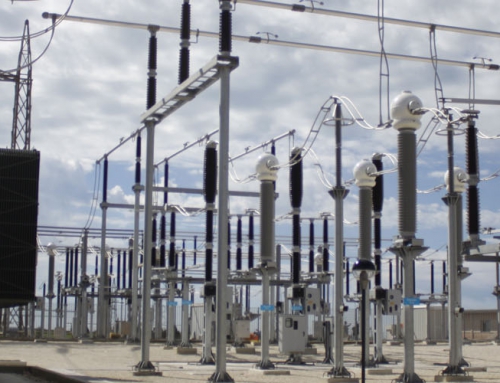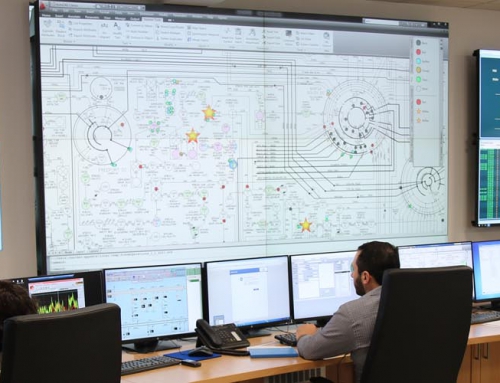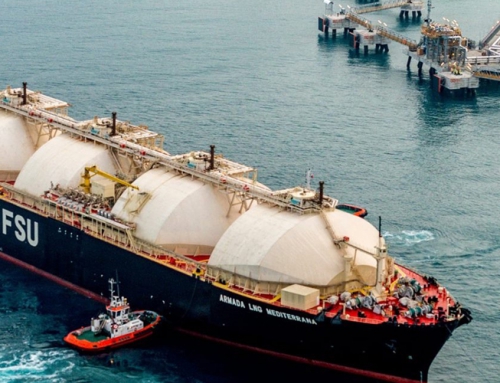History of electricity
|
2017
The last heavy fuel oil power plant in operation in Malta, the 1992 Delimara 1 plant, is switched off and put on cold standby on 24th April 2017.
On the same day, Electrogas Malta inaugurates the new Delimara 4 gas-fired CCGT plant and related LNG supply and regasification facilities.
As from this day, Malta’s electricity generation mix is no longer dependant on heavy fuel oil plants to ensure an adequate level of security of supply. Instead, the country is adopting a diversified energy mix based on two gas-fired plants, the Malta-Italy Interconnector, grid-connected renewable energy sources and an adequate level of emergency capacity through the gasoil-fired Delimara 2 plants.
2017
As the new gas-fired plant and the gas-converted Delimara 3 plant at Delimara are undergoing final testing and start generating electricity, the Marsa Power Station is no longer required to remain on cold standby. It is completely disconnected from the national grid so that it can continue to be demolished on 12th March 2017.
2015
On the 9th April 2015, the Prime Minister of Malta and the Prime Minister of Italy inaugurate the 120-kilometre 200 MW Malta-Italy Interconnector, linking the Maltese electricity grid to the European energy network.
2015
On 9 March 2015, the Marsa Power Station is switched off and put on cold standby, pending final decommissioning. The dismantling this 62-year-old power station is already underway. 2014
In December 2014, Enemalta signs a multi-million strategic investment agreement with Shanghai Electric Power, through which the triple-A rated international energy services provider acquired a 33% shareholding in Enemalta plc. The two Companies also launch two joint ventures, which will enable Enemalta to open up new business opportunities in the Mediterranean region, and beyond, in two growing sectors – renewable energy projects and energy generation and distribution maintenance and servicing. 2014
On 25 August, Enemalta plc is established to take over the electricity generation and distribution infrastructure and operations formerly administered by Enemalta Corporation. The Corporation’s Petroleum Division is hived off into a separate government entity, Enemed Co. Ltd. 2013
Following a new government policy, Enemalta launches major projects to stop using heavy fuel oil in its electricity generation mix and instead shift to natural gas. This shift is expected to lead to substantial air quality improvements and a reduction in generation costs. The projects include the building of a new plant at Delimara and the decommissioning of old generating units operated by Enemalta.
2012
The new 149MW Delimara extension, including eight Wartsila diesel engines operating in combined cycle mode and one steam turbine, is officially taken over by Enemalta on 14 December 2012.
2010
On 14 December 2010, Enemalta together with the Department of Contracts and the Ministry of Finance signed the adjudication tender contract with Nexans, for the building of a Malta-Sicily Interconnector, which will see the island’s electricity grid connected via sub-sea cable to mainland Europe.
2005
In 2005 Enemalta commits itself to purchase renewable energy generated on the Maltese islands.
2001
In 2001 Enemalta re-commissioned the Electrostatic precipitators which were originally installed on the coal fired boilers for operation on the oil fired boilers at the Marsa power station to reduce dust emission by 99%
1999
Enemalta commissioned a combined cycle generation plant in 1999 using 0.2% sulphur gas oil.
1995
In April 1995 Enemalta stopped using coal as fuel for its generation plants, reducing CO2and dust emissions.
1994
The underground A Station is decommissioned.
1990
Another 37 MW open cycle GE frame 6 gas turbine is added to the Marsa plant in 1990.
1978-1987
As demand for electricity continued to rise, the Marsa Power Station implemented several projects to extend its generating capacity. Three 30MW General Electric / Ansaldo San Giorgio turbines were brought to Malta from Palermo, Sicily and reassembled at the Marsa Power Station by Malta Drydocks and Enemalta employees. During the same period, another two boilers, Boiler 7 and Boiler 8, each capable of producing 60MW of steam, were procured from the UK and installed at the same plant. In 1987, a 60MW Parsons / Rolls Royce steam turbine was brought to Malta from Little Barford, UK.
1977
On 1st October, new legislation is introduced to set up Enemalta, a new Government corporation entrusted with the development and operation of the country’s energy requirements, including electricity, gas and petroleum fuels. Through this law, Enemalta took over from the Malta Electricity Board, the Gas Board and the Oil Section of the Ministry of Development, Energy, Ports and Telecommunications.
1970-1971
The B Station continued to be extended with two 30MW boilers and Franco Tosi steam turbines. A three one million gallon/day seawater distillation unit was also inaugurated.
1966
The new Power Station, known as the Marsa B station, was inaugurated. This station, which was built above-ground next to the underground station, housed two Franco Tosi 12.5 MW Turbo Alternator Units. It also housed a million gallon per day desalination plant that provided water supply to nearby towns. In this regard, the station became the first power and water plants in the world.
1960 – 1965
Due to the constant demand for electricity supply and due to the diversification of the Island’s economy, in 1960 the underground station at Marsa is extended by two Metropolitan Vickers 5 MW steam turbines. Five years later, it is again extended by a Fiat 5.7 MW Gas Turbo Alternator. Due to lack of space in the underground galleries which housed this station, it was decided that a new Power Station should be erected next to it.
1954-1959
The demand to supply electricity to the most remote villages, especially those in the North of the Island, was being continuously pursued by residents. In order to keep up with the demand, the Government commissioned a feasibility study to see what steps were to be taken. It was recommended that it was more viable to serve Gozo from the Power Station in Malta and in 1957 two submarine cables were laid from Marfa to Comino and from Comino to Gozo. This was commissioned in 1958. During January 1959, the Gozo Power Station stopped operating and another chapter in the history of electricity of the Maltese islands came to an end.
1954-1958
Following the commissioning of the new Power Station, a new era started. The introduction of a 3-phase 50 cycle system necessitated the complete changeover of the distribution network installations and equipment. This ambitious programme commenced in 1954 and lasted four years. This task demanded co-ordination of labour and material resources to be completed within such a short timeframe. These years were known as the “changeover period” when the electricity supply and distribution network were converted from single-phase 100 cycles to three-phases 50 cycles. The reconstruction of the distribution system involved the laying of 11kV three-phase cables and the erection of 11kV overhead lines, construction of new substations and the stringing of 3-phase 415/240v service mains.
1953
The new Power Station, which was installed in the galleries excavated at the base of Jesuits Hill, in Marsa, was inaugurated on 5th December 1953. This generated electricity at three phases 50 cycles through three Westinghouse 5MW steam turbines. The installed capacity of this new equipment was 15 MW.
1949 (GOZO)
In 1949 a new unit with a capacity of 120 kW was installed in Gozo. This brought the overall capacity to 180 kW because some of the old equipment was also replaced. During the same period an alternator with a capacity of 200kW was also installed to be able to provide for the existing electricity demand. The new equipment was inaugurated in August 1951. Because of this improvement electricity was also introduced in some of the Island’s rural villages by 1953.
1948 – 1949
Following World War II the Maltese Government sought help under the Marshall Aid Scheme for the recovery of war-torn Europe. Financial support was sought to finance the cost of the plant and equipment for a new Power Station to finally replace the one at Lascaris Wharf. The Economic Administration of the United States of America, after more than a year of discussions, approved this grant.
1936 (GOZO)
Ten years after the introduction of electricity on the island of Gozo, the 3-phase 50-cycle system was approved by the government.
1935
Proposals for a larger plant were brought up again in 1935 and this proposal once more included the conversion of the out-dated distribution system to the standard 50-cycle 3-phase operation. However, the onset of World War II meant that these plans were once again put on hold.
1922 – 1933
In 1920 a recommendation was made to replace the old engine driven alternators at the Lascaris Power Station by a steam turbine system set of a higher capacity. This would have included, the introduction of the 3-phase 50 cycle operation system. Because of the high costs involved, this proposal was declined by the Government of the day. Two years later, following a report on the electricity supply in Malta, the system proposed was introduced.
1925 – 31 (GOZO) Following a decision taken in 1925, a Power Station was built in St. Domenica Street in Victoria Gozo. The supply was inaugurated on 1 August 1926. The generating plant consisted of two units by 44 kVA Diesel Alternator Sets. The electricity demand was rather restricted in Gozo mainly due to the fact that it was an agrarian society with very little mechanised industry. Thus the electricity was mainly used for lighting purposes. In 1931 more equipment was added, bringing the capacity to 94 kVA. During this period the supply was provided mainly after dusk and on some occasions during daytime.
1904 – 1915
During this period, due to the expansion of the electricity system in Malta, more generating units were added to the existing plant. During 1904 two generating units having a capacity of 600 KW were installed. These were purchased from Westinghouse Beliss, and ECC Beliss respectively. Another plant was installed in 1915 increasing the generating capacity by another 500 KW. This plant was ordered from Ljungstrom Brush.
1894-1896
The year 1894 saw the rise of the first public electricity service in the Maltese Islands. The Central Power Station, as it was known at that time, was erected at the foot of Crucifix Hill overlooking the Grand Harbour in the limits of Floriana. The equipment included a set of four steam-driven generating units with a capacity of 350KW. At the very beginning it was used for street lighting but then it ousted the town gas as an illuminant in houses and other buildings, and later on in industry. The first public electric lighting was installed at Valletta and Floriana. During the same year the supply was extended to Hamrun, Bormla, Birgu and Isla (Cottonera). The supply at that time was single phase at 100 cycles. The plant was scheduled to be inaugurated in 1895 but due to difficulties and delays of work it was extended to the following year. The first generating plant was ordered from Modley Brush.
1890
The Government of Malta, with the intervention of the Secretary of State for the Colonies commissioned the first feasibility study (which included both technical and economic aspects) to advise on the introduction of electric current supply in Malta. This report was prepared by Mr. William H. Preece, Consulting Engineer, and was forwarded to Government of Malta on 1 December 1890.
The report recommended the introduction of high-pressure alternate current system to provide power for 10,000 lamps of 10-candle power each. It was estimated that the plant would cost £40,000. The project included the extension of the mains to Valletta, Floriana, the Three Cities, Hamrun and Sliema.
1883
On behalf of the eastern Electric Light and Power Co. Ltd, Chev. Edward Rosenbusch conducted the first demonstration of electricity for consumer use at his private residence, at 27, Merchant Street, Valletta. He invited several local dignitaries and members of the public to witness the beginning of a new era of electricity supply for consumers. During this demonstration he set up a simple electric lighting installation.
1882
Electric lighting was introduced for the first time in Malta during the opera Un Ballo in Maschera at the Royal Opera House, in Valletta. During the same year, Piazza San Giorgio was also illuminated by electric lighting.
|
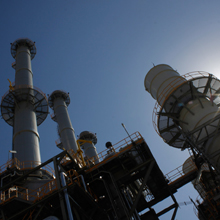 The Delimara 4 gas-fired power station  The Prime Minister and Marsaxlokk and Birzebbugia children shut down the HFO pipeline at the Delimara Power Station The Prime Minister and Marsaxlokk and Birzebbugia children shut down the HFO pipeline at the Delimara Power Station
Dismantling of chimney at Marsa Power Station
|

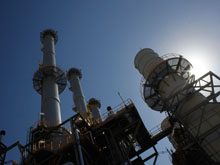 The Delimara 4 gas-fired CCGT plant
The Delimara 4 gas-fired CCGT plant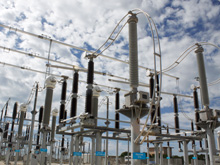 Malta – Italy Interconnector
Malta – Italy Interconnector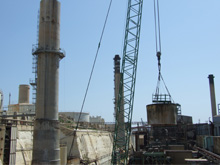
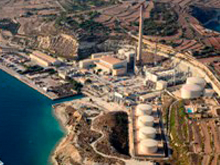 The Delimara Power Station
The Delimara Power Station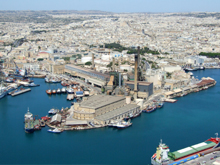 The Marsa Power Station
The Marsa Power Station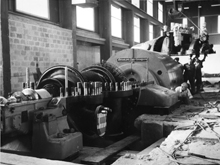 Workers assembling one of the three 30MW turbines at the Marsa Power Station (1978 – 1987)
Workers assembling one of the three 30MW turbines at the Marsa Power Station (1978 – 1987)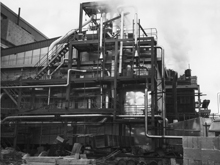 One of the B Station’s boilers, soon after it was erected.
One of the B Station’s boilers, soon after it was erected.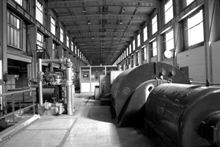 The B Station’s turbine hall.
The B Station’s turbine hall.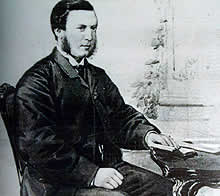 William H. Preece, (1864) who was the first consultant for the Malta Government in connection with the electricity supply in Malta
William H. Preece, (1864) who was the first consultant for the Malta Government in connection with the electricity supply in Malta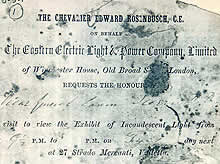 Invitation for a demonstration of electricity lighting in a private house in Valletta in 1894, by Chevalier Edward Rosenbusch
Invitation for a demonstration of electricity lighting in a private house in Valletta in 1894, by Chevalier Edward Rosenbusch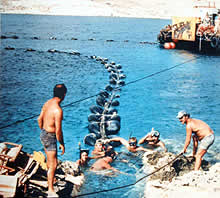 Lying of the submarine cable between Malta/Comino/Gozo Channel to supply electricity for the mainland
Lying of the submarine cable between Malta/Comino/Gozo Channel to supply electricity for the mainland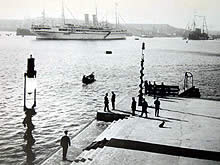 Decorative lamps posts at the Customs place in the early fifties
Decorative lamps posts at the Customs place in the early fifties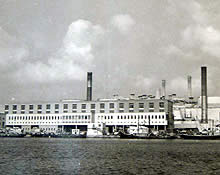 The Malta Water Power Station at Marsa
The Malta Water Power Station at Marsa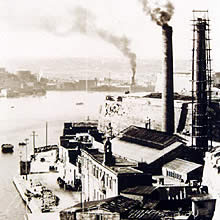 The first Malta Power Station erected at Crucifix Hill Floriana in 1895. Photo taken in the late forties after the Second World War.
The first Malta Power Station erected at Crucifix Hill Floriana in 1895. Photo taken in the late forties after the Second World War.
